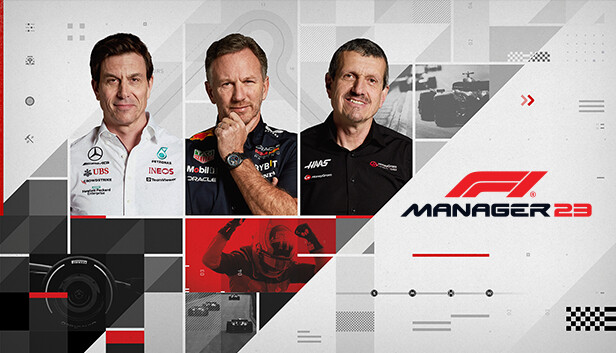For F1 Manager 2023 players, this guide is trying to determine the starting difficulty of each team. As the sections progress, the analysis will be deepened, and more details will come into play and be explained.
Intro
It seems that this year’s game is more difficult for many players than the 2022 edition, so let’s find out why!
The worst thing that can happen is to be fired at the end of the season, and that’s catastrophic!
All these investments for the 2024 season will have been for nothing, so it’s impossible to continue with the plan implemented for the team’s future success, and we have to start all over again…
They can be financial:
- Debt (even temporary)
- Exceeding the budget cap (refer to Money section of this guide)
They can also be sporting:
- Not satisfying the board (race performance)
- Failure to reach season objective
- Failure to reach long-term objective in due year (should not concern 1st season)
The 5 Commandments for Managers listed above are your objectives.
- Failure to comply with more than one will probably result in dismissal
- Failure to comply with just one may result in dismissal, depending on its severity
- Complying with all of them ensures that you won’t be dismissed
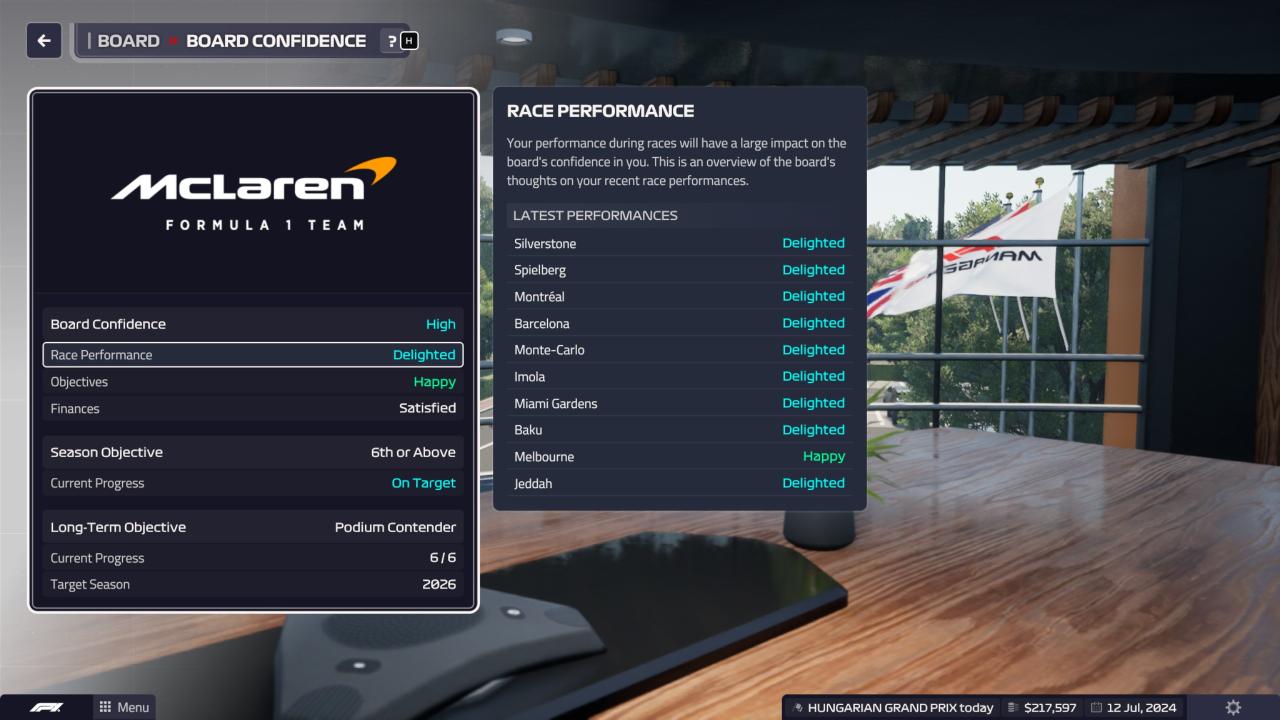
Money
Money is an essential element in the difficulty of the game, which is why it is necessary to have some basic knowledge.
The game starts on February 20th, so there will only be 10 payments from the board.
- The initial balance
- The fixed amount paid by the board on the 1st of each month
- The base amount paid by the sponsors for each of the 23 races
- Sponsor bonuses and guarantees.
Sponsor bonuses and guarantees can be more or less easy to obtain, depending on the objectives set by the sponsors for the bonuses, and the guarantees you choose.
Be careful with guarantees: not reaching them will cost you a penalty on the base amount paid by the sponsors!
Recently introduced in F1, the budget cap limits the amount of spending authorized by teams, in order to reduce the gap between them, which used to be several hundred million.
It is set at 139 200 000$ and mainly covers running costs (cost of running the facilities, staff salaries – except for the drivers) as well as parts design and research for the following year’s car.
Facilities upgrades are not included in the budget cap.
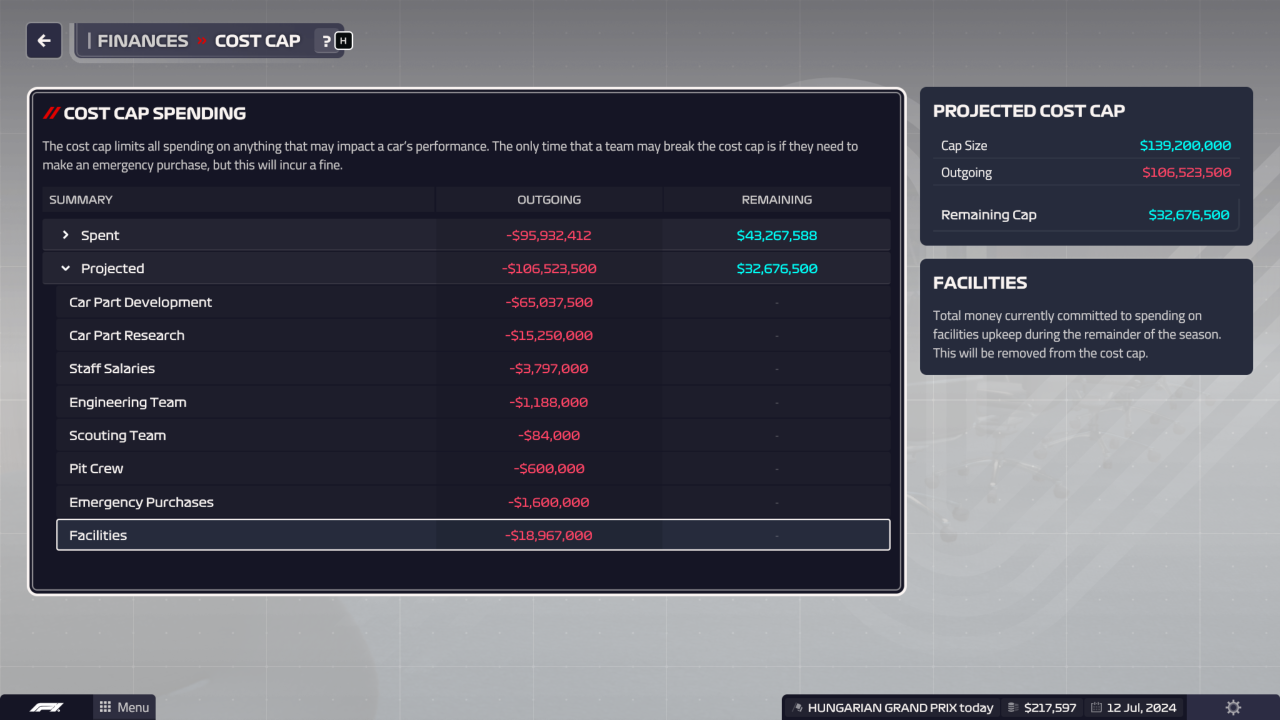

As illustrated, the major differences concern the initial balance as well as the amount that can be allocated to facilities: all teams earn enough money, even without any sponsor bonuses, to cover the remaining budget cap.
Ratings, objectives and relative difficulty
The main value to consider is the car’s performance ranking:
- The level of facilities can bring some advantages, but they are mostly minimal
- The level of staff can make a difference in very specific cases, but they are not the key to success in the first season
- Drivers come into play mainly if they destroy too many cars over the year, as this will have financial repercussions (budget cap!)
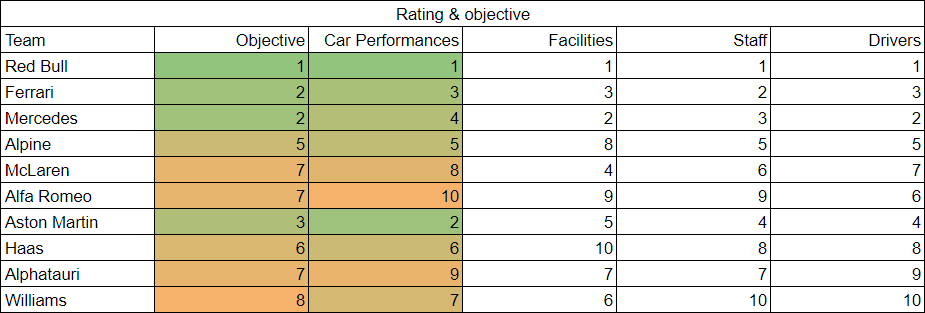
To get a basic idea of how difficult a first season can be, you need to compare the car’s rank with its objective:
- If the car’s rank is higher than the objective: rather easy
- If the car’s rank is equal to the objective: easy to medium, the other ranks may have more impact
- If the car’s rank is below the objective: medium to very difficult, depending on the difference and the competition for the same objective
- McLaren car is #8, objective is #7 – difference = 1
- Alphatauri car is #9, objective is #7 – difference = 2
- Alfa Romeo car is #10, objective is #7 – difference = 3
- Williams car is #7, objective is #8 – difference = -1
We can deduce that:
- Starting with McLaren, the main competitor should be Williams
- Starting with Alfa Romeo, there’s a lot more competition: Williams, McLaren and Alphatauri, and beginning with the worst car!
- Starting with Williams, there should be no problem finishing 8th
Apply the above “formula”, based on car position and team objective from the table above, with, if necessary, the competitors.
- Ferrari car #3 performs better than Aston Martin car #2 in most cases
- Alpine car #5 performs almost the same as Mercedes car #4 in most cases
Related to each team, it’s obvious that if you already know what you’re doing and why you’re doing it, most of them should be more or less easy to manage.
- Red Bull – very easy
- Ferrari – easy
- Mercedes – hard to very hard
- Alpine – easy
- McLaren – medium to hard
- Alfa Romeo – very hard
- Aston Martin – very easy
- Haas – easy
- Alphatauri – hard to very hard
- Willams – very easy
Notes about above difficulty:
- Your 1st race should follow the above difficulty
- From the 2nd and 3rd race, you will have new parts designed, as will the AI teams, which means that at this point, your career will be totally unique
- This also means that the difficulty may vary more or less from this point on, depending on your design decision and the AI’s design decisions
Car analysis basics
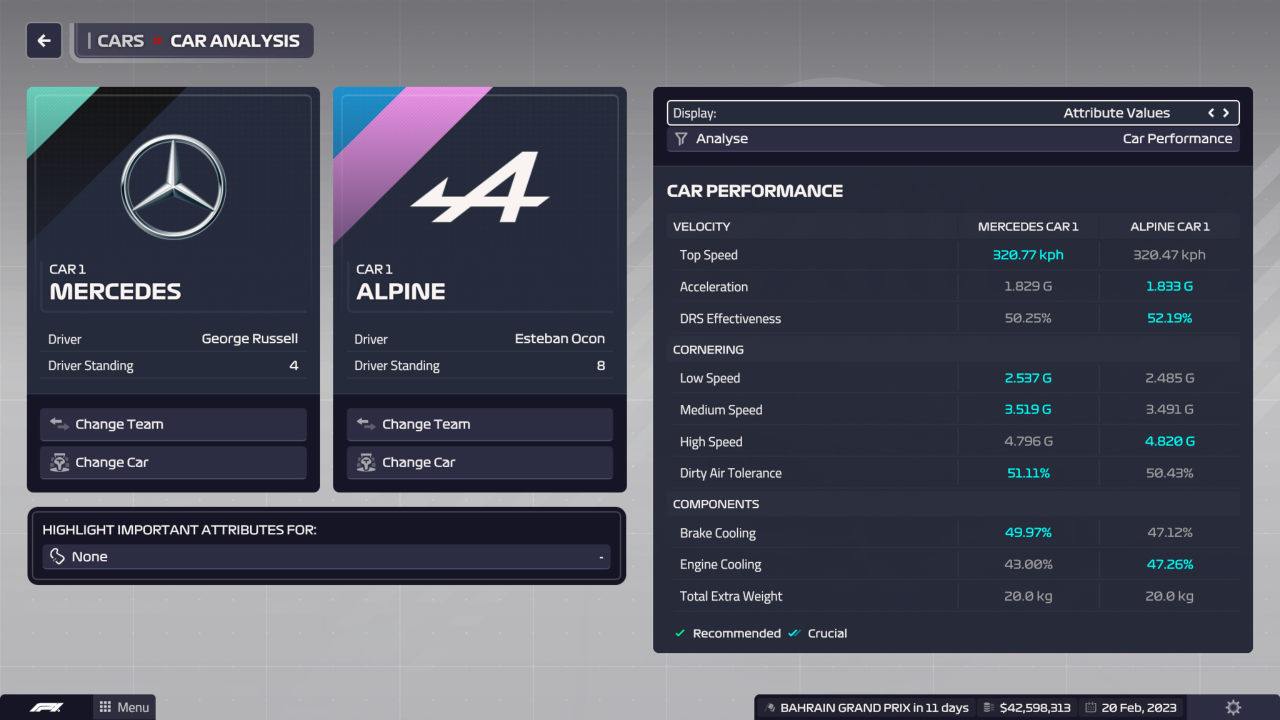
Let’s take a moment to analyze the differences between cars #4 and #5:
- Top speed is very close, to the advantage of Mercedes
- The effectiveness of the DRS is better on the Alpine, which certainly goes faster than the Mercedes when it’s used
- The Mercedes is better at low and medium speed cornering, i.e. on slow circuits
- The Alpine is better at high speed cornering, i.e. on fast circuits
- Dirty Air Tolerance is very close
- Cooling can be ignored
- kph – used only for max speed
- G – the result of an obfuscated calculation
- % – the current value from min value to max value
- Low speed – 3 to 5 kN – 4 is 50%
- Med speed – 5 to 7 kN – 6 is 50%
- High speed – 7 to 8 kN – 7.5 is 50%
It is also possible to show the detail of each part:
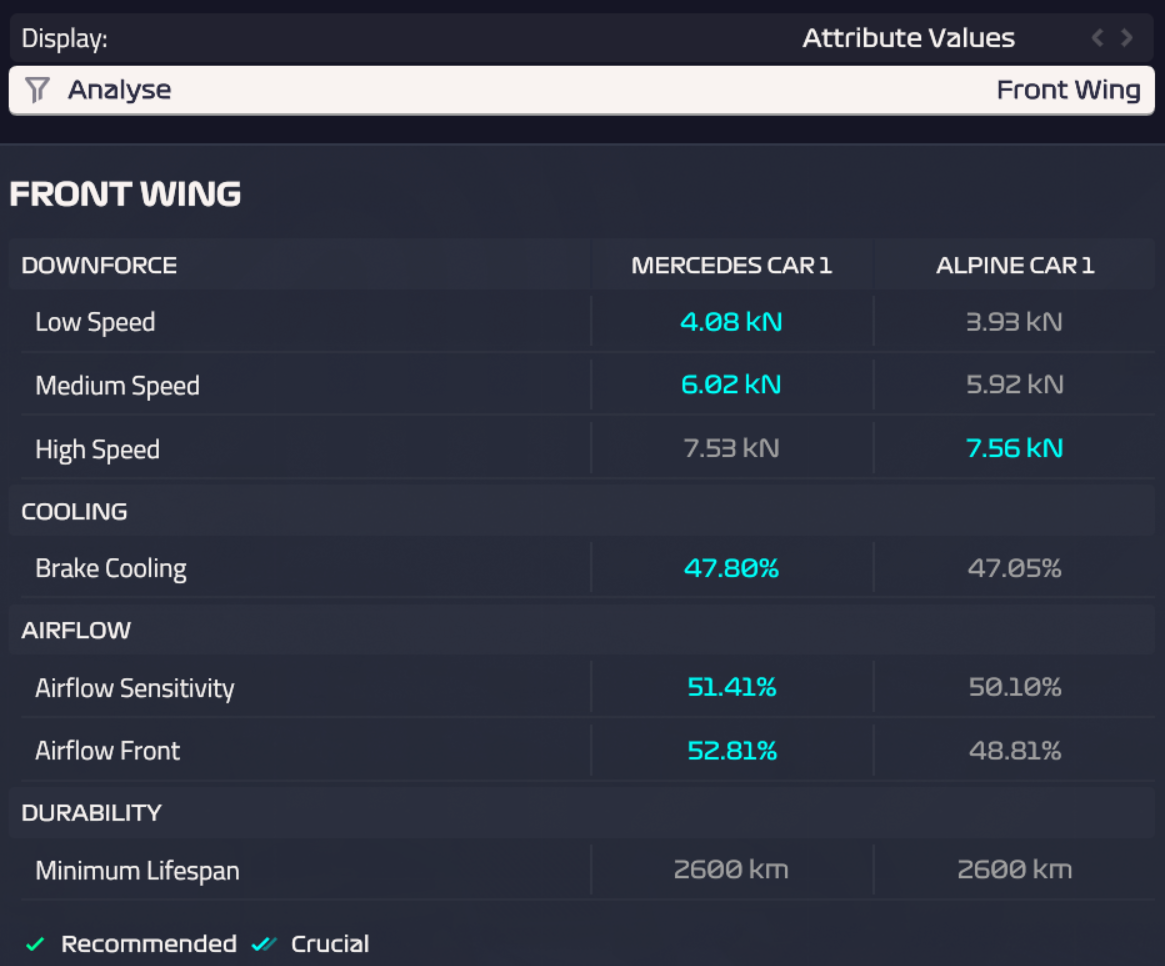
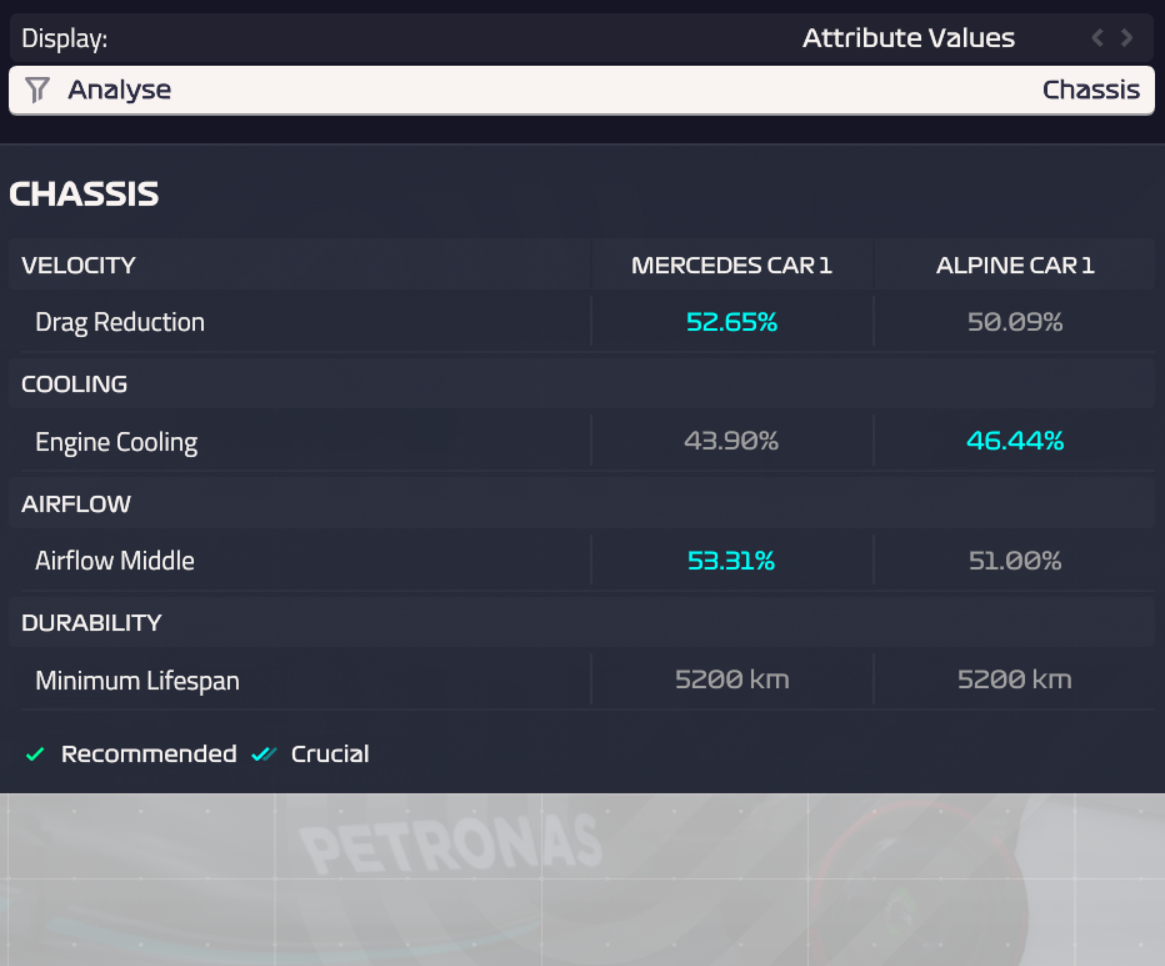
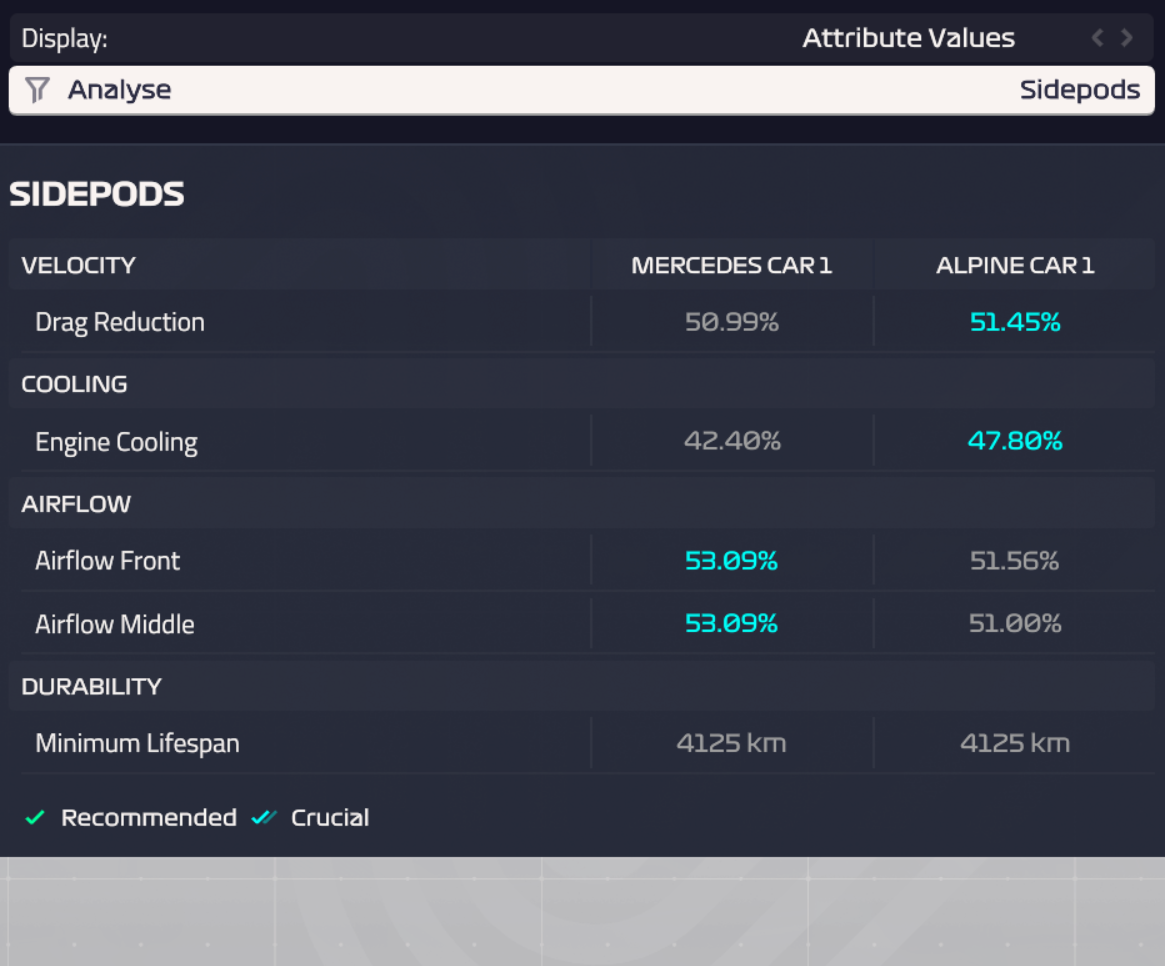
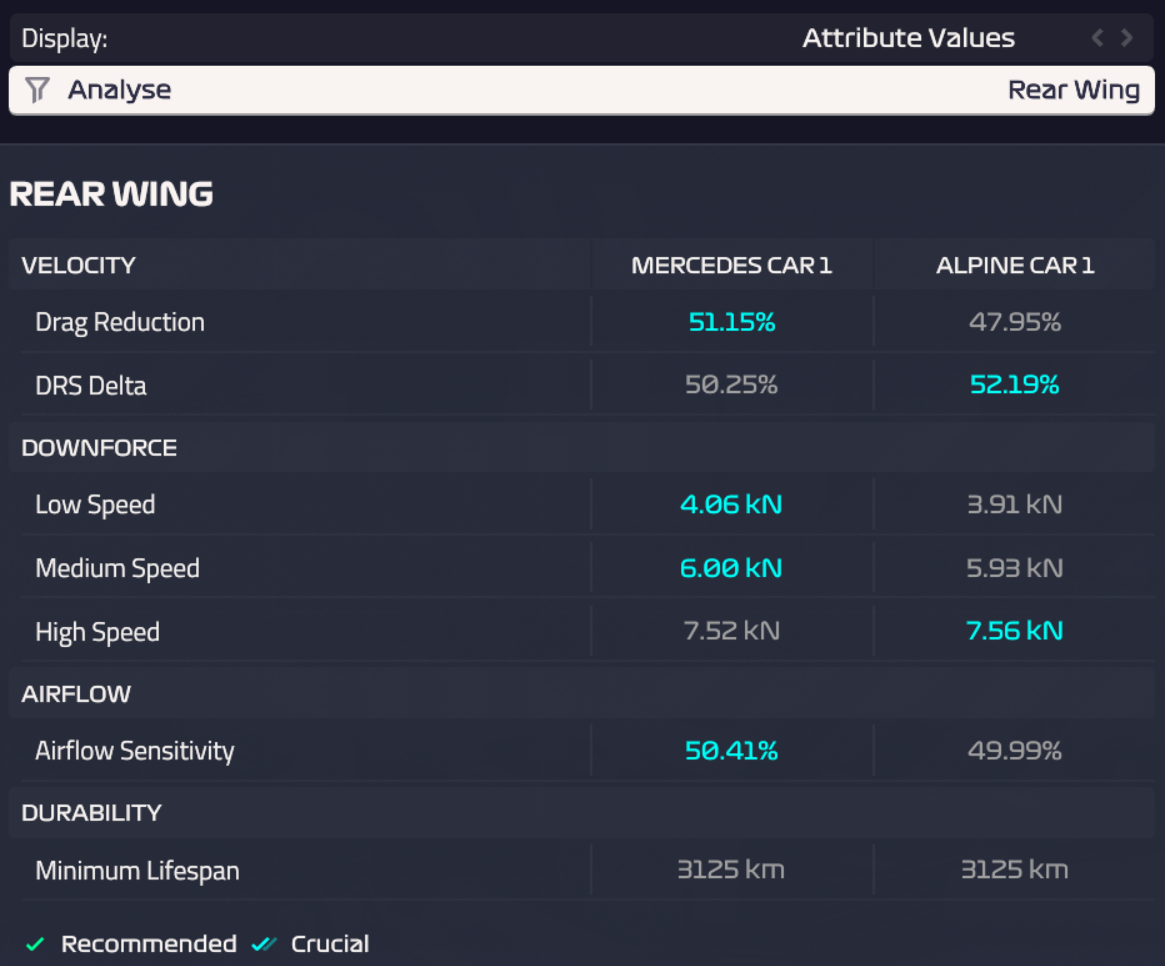
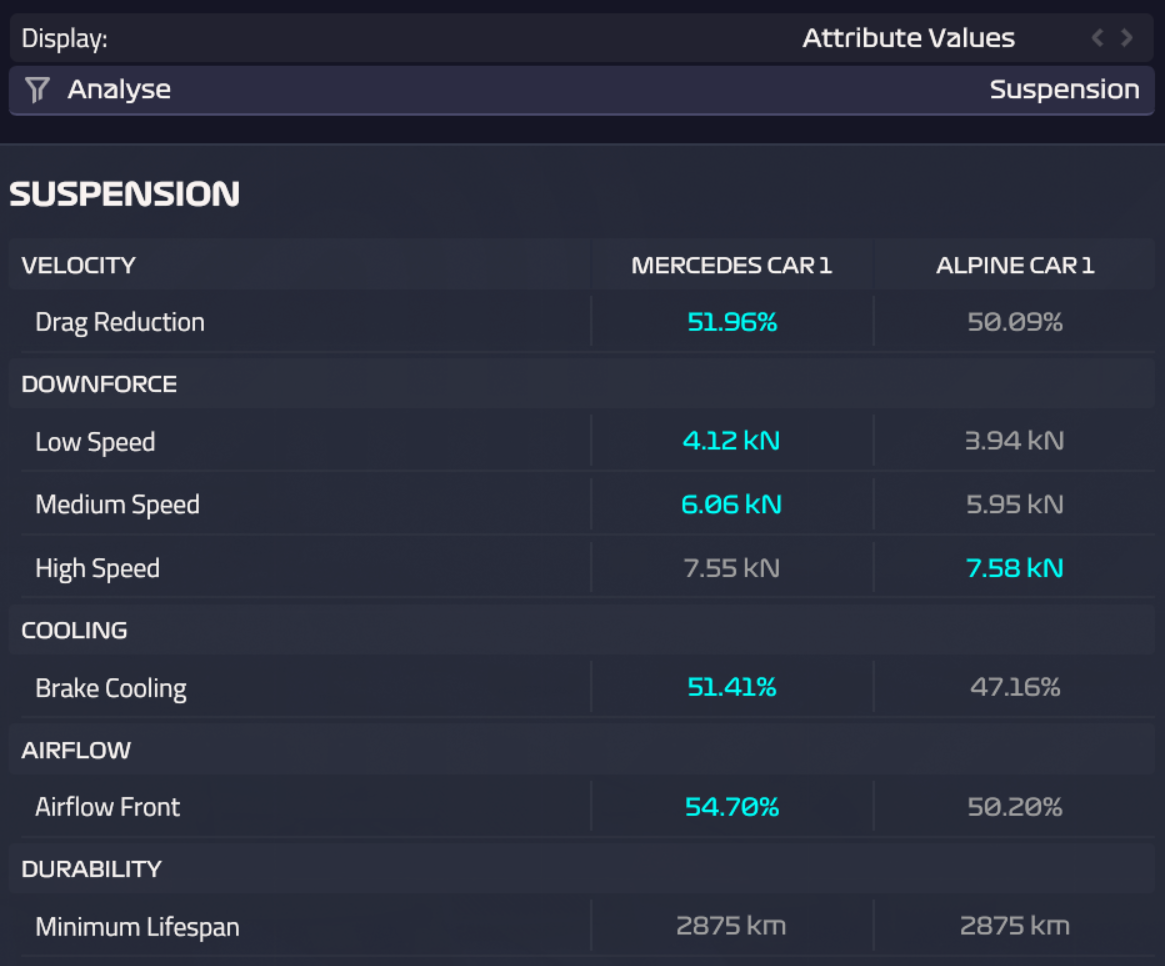
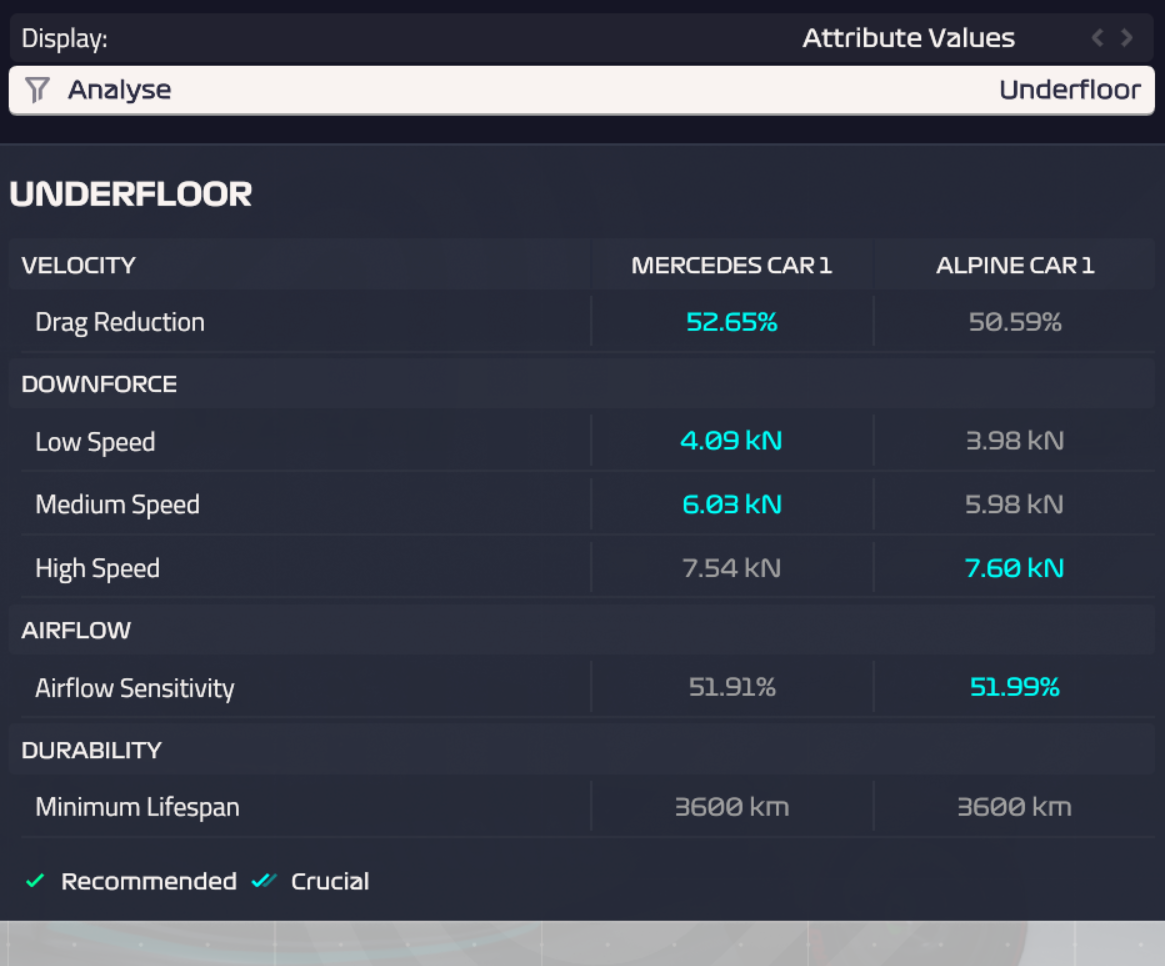
These are the values you’ll see when you go to design (and research afterwards).
- The same stat on two different parts has its own value, which represents the staff’s expertise on that stat on that part / the car’s performance on that stat on that part
- Drag reduction is the max speed stat
- DRS delta is the DRS effectiveness stat
- The cornering values (in G) are the result of a calculation that includes the different cornering stat on the different parts, as well as the airflow front and airflow middle stats
- Airflow sensitivity represents the tolerance to dirty air, to which a car is subjected when it is less than half a second from another car
- Cooling stats are not directly related to performance
Each car is equipped with a powertrain (engine + ERS + gearbox), which may come from different manufacturers:
- Red Bull
- Ferrari
- Renault
- Mercedes
Each of the above powertrain has its own characteristics, and it is not possible to change them before the start of the 2024 season.
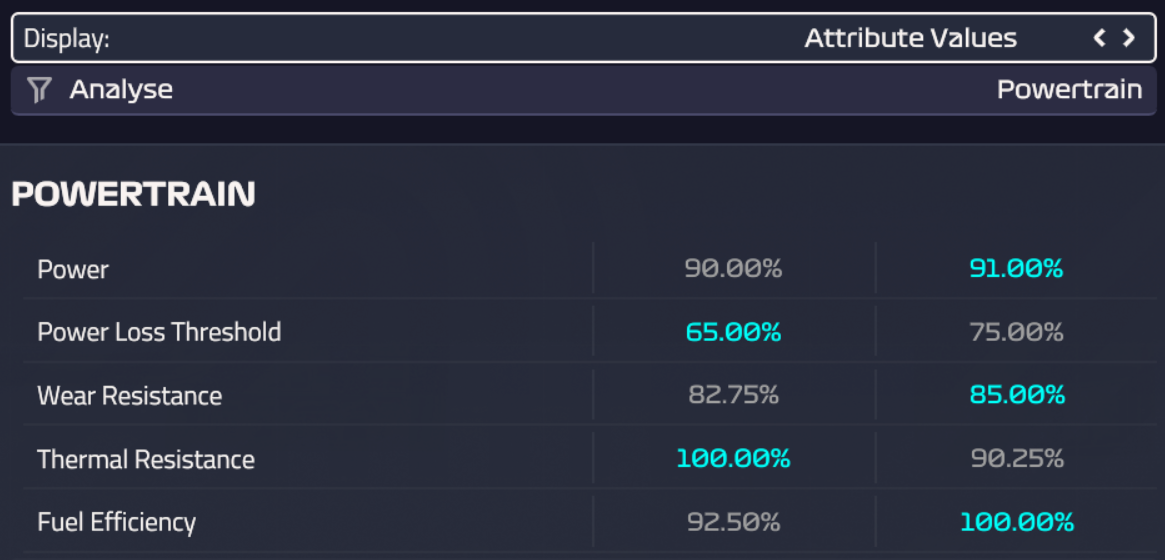
- Power is max reachable max speed (higher is better)
- Red Bull 100%
- Ferrari 95%
- Renault 91%
- Mercedes 90%
- At 100% drag reduction, the difference between Red Bull and Mercedes engine is 1 kph
- Power is also the main stat affecting a car’s acceleration
- Power loss threshold is the point at which the engine begins to lose power (lower is better)
- Wear resistance determines the rate at which powertrain parts degrade (higher is better)
- Thermal resistance indicates the need for good powertrain cooling on other parts of the car (higher is better if your car has a low engine cooling value)
- Fuel efficiency determines how much excess fuel must be taken on board at the start of a race in order to finish it (higher is better)
This stat is very special in that it has an indirect impact on a car’s pace over the duration of a race: it improves tyres cooling, and therefore potentially the rate of degradation of tyres even when driving at a more aggressive pace.
So it can help in certain cases, but it’s clearly not the stat I would focus on first season, especially for bottom teams.
